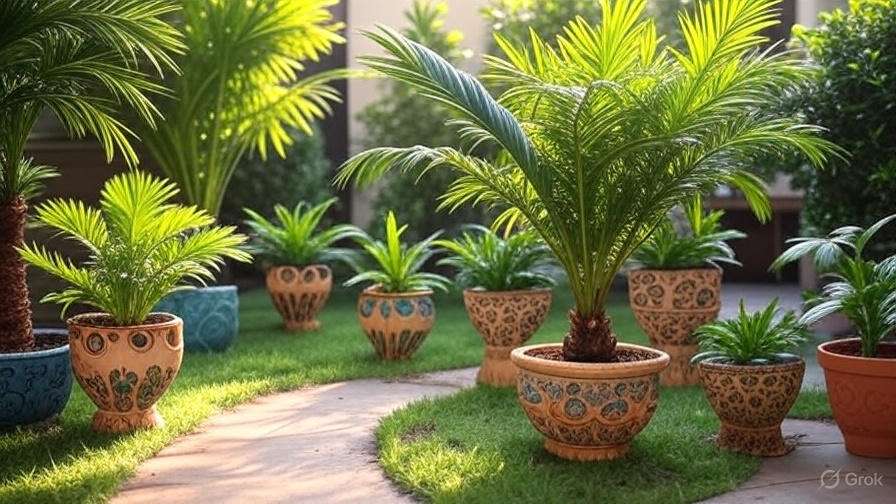
Small Palm Trees: How to Grow and Care for the Best Compact Palms for Your Home and Garden
Are you dreaming of adding a tropical touch to your home or garden, but don’t have the space for large trees? 
In this guide, we’ll walk you through everything you need to know about growing and caring for small palm trees. From choosing the right variety for your space to mastering the art of palm care, we’ve got you covered. By the end of this article, you’ll have all the tips and tricks to successfully grow healthy and stunning small palms in your home or garden. Ready to transform your space? Let’s dive in!
Table of Contents
ToggleWhat Are Small Palm Trees? 
Small palm trees are compact, low-maintenance plants that bring a tropical vibe to any space. Unlike their towering cousins, these palms are perfect for smaller homes, apartments, or gardens where space is limited. Whether grown indoors or outdoors, small palms can add a touch of greenery without overwhelming the area.
Key Features of Small Palm Trees:
- Compact Size: Small palms typically reach a height of 2 to 6 feet, making them ideal for tight spaces.
- Low Maintenance: These palms are generally easy to care for, requiring minimal pruning and occasional watering.
- Aesthetic Appeal: With their attractive fronds and elegant appearance, small palms elevate the decor of any room or garden.
Some popular varieties include the Parlor Palm, Areca Palm, and Pygmy Date Palm. Each has its own unique characteristics but shares the common trait of being small in size and adaptable to a range of indoor and outdoor environments.
Why Choose Small Palm Trees?
- Space-Friendly: Their compact nature makes them perfect for apartments, small yards, or office spaces.
- Versatile: They can thrive in various conditions, including low light, making them great for indoor environments.
- Low Maintenance: Ideal for beginners, small palms are forgiving and can tolerate minor care lapses.
Small palm trees offer a low-maintenance way to add a tropical touch to your space. They are the perfect option for anyone looking to enjoy the beauty of palm trees without the hassle of large, space-consuming plants.

Best Small Palm Trees for Home and Garden 
Small palm trees are a fantastic way to add a touch of tropical elegance to your home or garden without overwhelming the space. Whether you have a cozy apartment, a small garden, or want to create a relaxing corner in your living room, the right compact palm can transform your space. Here’s a list of the best small palm trees to grow and care for, perfect for both indoors and outdoors!
1. Areca Palm (Dypsis lutescens) 
Areca palms, also known as butterfly palms, are popular for their feathery, arching fronds that create a lush, tropical look. These palms are relatively easy to care for, making them ideal for beginners. They thrive in bright, indirect light and require moderate watering. Keep the soil slightly moist, but avoid overwatering to prevent root rot.
- Height: 6 to 7 feet (indoors)
- Care Tips: Prefers humidity, so misting the leaves occasionally helps.
2. Parlor Palm (Chamaedorea elegans) 
Parlor palms are low-maintenance and do well in low light, making them perfect for indoor environments. They have elegant, feathery fronds that can brighten any room. These palms are also known for their air-purifying properties, making them a healthy addition to your home.
- Height: 3 to 4 feet (indoors)
- Care Tips: Water regularly but let the soil dry out between waterings. It’s adaptable to a range of lighting conditions.
3. Pygmy Date Palm (Phoenix roebelenii) 
If you’re looking for a palm that brings an exotic flair but doesn’t take up too much space, the pygmy date palm is a great choice. It features a slender trunk and dense, feathery leaves. This palm grows well in containers and can tolerate direct sunlight, making it perfect for a sunny corner.
- Height: 4 to 6 feet (indoors)
- Care Tips: Keep the soil slightly dry, as it’s sensitive to overwatering. It enjoys bright, indirect light.
4. Bamboo Palm (Chamaedorea seifrizii) 
Bamboo palms are another excellent choice for both indoor and outdoor spaces. Known for their elegant, bamboo-like stems and lush, dark green leaves, these palms are particularly good at removing toxins from the air. They thrive in low to moderate light and are relatively easy to maintain.
- Height: 4 to 6 feet (indoors)
- Care Tips: Keep the soil moist but not soggy. They also prefer moderate humidity.
5. Kentia Palm (Howea forsteriana) 
Kentia palms are perfect for a stylish, minimalist touch in your home. With long, arching leaves and a sleek appearance, they’re a go-to for modern interiors. These palms are slow-growing, making them an excellent option for small spaces.
- Height: 4 to 10 feet (indoors)
- Care Tips: They prefer low to moderate light and require occasional watering when the soil dries out. Kentia palms do well in average humidity.
6. Camas Palm (Chamaerops humilis) 
If you’re looking to add a bit of a Mediterranean vibe to your garden, the Camas palm is a great choice. With its fan-shaped leaves and compact growth, it’s perfect for small gardens or even patio spaces. It’s cold-hardy, making it suitable for outdoor spaces in mild climates.
- Height: 3 to 6 feet (outdoors)
- Care Tips: Thrives in full sun but can tolerate partial shade. Water deeply but let the soil dry out between waterings.
Care Tips for Small Palm Trees 
- Lighting: Most small palms thrive in bright, indirect light. Avoid direct sunlight, especially for indoor palms, as it can scorch their leaves.
- Watering: Overwatering is a common mistake. Ensure the soil is well-draining and water only when the top inch of soil feels dry.
- Humidity: Many small palms appreciate higher humidity, so consider placing a humidifier nearby or misting them occasionally.
- Fertilizing: Use a balanced, water-soluble fertilizer during the growing season (spring and summer) to promote healthy growth.
With these palms, you can create a cozy, tropical escape in your own home or garden—without needing a lot of space. 

How to Grow Small Palm Trees: A Step-by-Step Guide 
Growing small palm trees in your home or garden can add a tropical, elegant touch to any space. Whether you’re looking to enhance your indoor decor or create a lush outdoor environment, small palms are easy to grow and care for. Here’s a beginner-friendly guide on how to grow small palm trees successfully, from choosing the right variety to providing the proper care.
1. Choose the Right Small Palm Tree 
Not all palm trees are suited for small spaces. Some popular small palm varieties that thrive indoors or in smaller gardens include:
- Areca Palm: Known for its feathery leaves and compact size, perfect for homes and offices.
- Parlor Palm: A low-maintenance indoor palm with elegant, arching fronds.
- Dwarf Palm (Pygmy Date Palm): A small palm variety ideal for garden containers or indoor pots.
When selecting a small palm, make sure it’s suited for your climate and space requirements. Indoor palms will thrive with lower light levels, while outdoor palms need a sunny spot.
2. Prepare the Perfect Pot and Soil 
Palms need well-draining soil to thrive. For potted palms, choose a pot with drainage holes to prevent water from pooling at the bottom, which can lead to root rot. Use a mix of potting soil combined with sand or perlite for better drainage.
- Pot Size: Start with a pot that’s 1-2 inches larger than the root ball. This gives the roots space to grow without overwhelming the plant.
- Soil: Look for a fast-draining, lightweight mix that keeps moisture without becoming waterlogged.
3. Proper Planting and Placement 
When planting, ensure the palm’s root ball is level with the surface of the soil. This helps prevent water from accumulating around the trunk and allows the roots to establish properly.
- Indoor Palms: Place them near bright, indirect light. They can tolerate lower light but grow best with some exposure to sunlight.
- Outdoor Palms: Choose a spot that gets filtered sunlight or partial shade, especially in hot climates, to prevent leaf burn.
4. Watering and Humidity 
Palms are sensitive to both overwatering and underwatering, so it’s important to keep the soil consistently moist but not soggy.
- Indoor Palms: Water when the top 1-2 inches of soil feels dry. Ensure the pot has good drainage to avoid waterlogged roots.
- Outdoor Palms: Water deeply, especially during dry periods, but allow the soil to dry out slightly between waterings.
For indoor palms, consider placing a humidifier nearby or misting the leaves occasionally. Palms thrive in higher humidity, so increasing moisture in the air can improve growth.
5. Fertilizing Small Palms 
Fertilizing helps small palm trees stay healthy and grow strong. Use a balanced, water-soluble fertilizer designed for palms. Apply during the growing season (spring through summer) every 4-6 weeks.
- Indoor Fertilizing: Reduce fertilization during the winter when the plant is dormant.
- Outdoor Fertilizing: Feed palms in the spring when new growth begins, and again in mid-summer.
Be cautious not to over-fertilize, as this can lead to nutrient imbalances or burn the roots.
6. Pruning and Maintenance 
Regular pruning helps maintain the shape of your small palm tree and removes any dead or damaged fronds. Here’s how to do it:
- Remove Dead Leaves: Cut off any brown, dried leaves at the base with clean, sharp scissors or pruning shears.
- Shape the Palm: Trim any fronds that are growing in unwanted directions to keep the tree looking neat.
Be careful not to trim too much, as cutting too many fronds can stress the plant.
7. Watch for Pests and Diseases 
Like all plants, small palms can sometimes attract pests like spider mites, mealybugs, or scale insects. Regularly inspect your palm for any signs of infestation, such as discolored or damaged leaves.
- Treatment: If you notice pests, wipe the leaves with a damp cloth or treat with an insecticidal soap or neem oil.
- Prevent Disease: Ensure good air circulation around your palm to prevent fungal issues. Avoid overwatering, which can lead to root rot.
8. Repotting Small Palms 
As your small palm grows, it may eventually outgrow its pot. Repot your palm every 1-2 years to give it more space for healthy root development. Choose a pot that’s 1-2 inches larger in diameter than the current one, and refresh the soil.
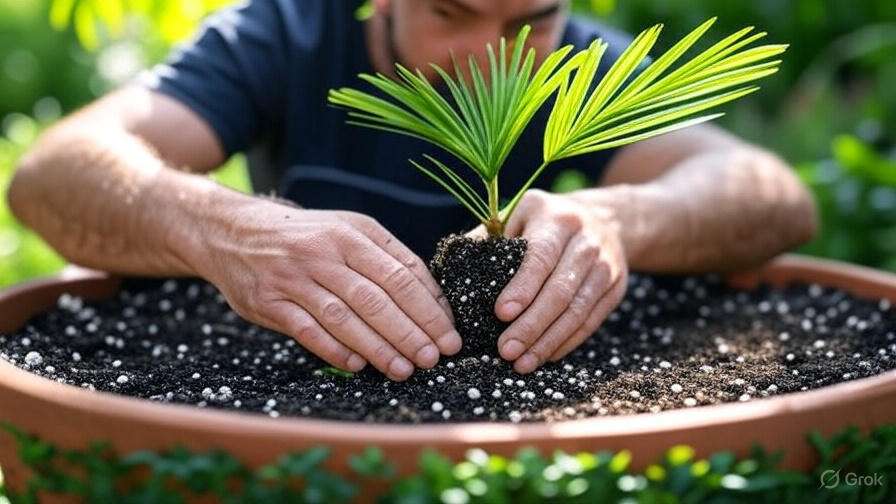
Essential Care Tips for Healthy Small Palm Trees 
Small palm trees can add a tropical touch to your home or garden, but they need the right care to thrive. Here’s a straightforward guide to help you keep your palm tree healthy and vibrant.
1. Choose the Right Location 
Palm trees love sunlight, so choose a spot that gets plenty of bright, indirect light. Whether you’re growing your palm indoors or outdoors, make sure it receives at least 6 hours of sunlight a day. If you’re growing it inside, placing it near a window is ideal.
2. Water Properly 
Small palms like consistent moisture but don’t want to be waterlogged. Water your palm when the top 1-2 inches of soil feel dry. Make sure the pot has good drainage to prevent root rot. Overwatering can be as harmful as underwatering, so be mindful of the balance.
3. Maintain Humidity 
Palms thrive in humid environments. If you’re growing your palm indoors, consider placing it in a humid room or using a humidity tray or humidifier. Misting the leaves occasionally can also help keep the humidity levels up.
4. Feed Monthly with Fertilizer 
Feed your palm tree with a balanced, slow-release fertilizer every 4-6 weeks during the growing season (spring and summer). A fertilizer rich in potassium, magnesium, and iron helps promote healthy growth and vibrant green leaves.
5. Repot When Necessary 
Small palms can outgrow their pots as they grow. When you notice the roots starting to crowd the pot, it’s time to repot. Choose a pot that is 1-2 inches larger in diameter and ensure it has proper drainage.
6. Trim Dead or Yellow Leaves 
To keep your palm looking its best, remove any dead or yellowing leaves. This not only improves its appearance but also helps redirect energy to healthier growth. Use clean, sharp scissors to avoid damaging the plant.
7. Watch for Pests 
Keep an eye on your palm for common pests like spider mites, aphids, or scale insects. If you spot any, treat your palm with an insecticidal soap or a natural remedy like neem oil. Regularly check the leaves and stems for signs of trouble.
By following these simple care tips, your small palm tree will stay healthy and beautiful, bringing a touch of the tropics to your space!
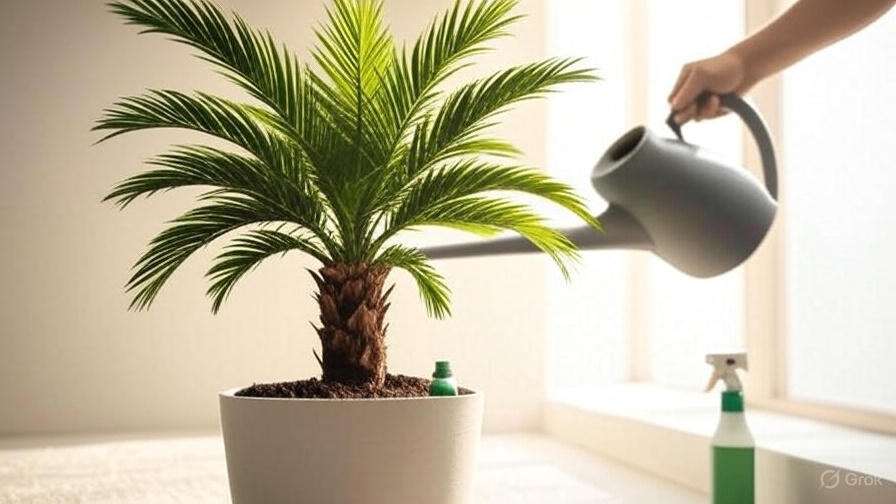
Troubleshooting: Common Problems with Small Palm Trees
While small palm trees can be a beautiful addition to your home or garden, they sometimes face a few challenges. Below are some common problems and easy solutions to keep your palms thriving.
1. Yellowing Leaves 
Yellowing leaves are a common issue with small palms, and it could indicate several things:
- Overwatering: Palms are sensitive to too much water. Ensure your palm is in well-drained soil and that the pot has drainage holes. Let the soil dry out slightly before watering again.
- Nutrient Deficiency: Palms need regular feeding. Use a palm-specific fertilizer with micronutrients like magnesium to prevent yellowing leaves.
- Pests: Check for pests like spider mites or scale insects, which can cause yellow spots. Use insecticidal soap to get rid of them.
2. Brown Tips on Leaves 
Brown tips can happen when your palm is not getting enough moisture or is exposed to cold drafts.
- Underwatering: Small palms, especially indoors, need consistent moisture. Ensure they’re not drying out too quickly by watering when the top 2 inches of soil are dry.
- Low Humidity: Many palm species prefer humidity. If the air in your home is dry, try placing your palm on a humidity tray or using a humidifier.
- Cold Drafts: Palms are sensitive to cold temperatures. Keep them away from drafty windows or air conditioning vents.
3. Stunted Growth 
If your palm is not growing as expected, it could be a sign of environmental stress.
- Insufficient Light: Small palms need bright, indirect light. If your palm is in a dark spot, consider moving it to a brighter location. Avoid direct sunlight, which can burn the leaves.
- Crowded Roots: If your palm is outgrowing its pot, it may be time to repot it into a slightly larger container. Ensure the new pot has good drainage.
- Too Much Fertilizer: Over Fertilizing can stunt growth and damage roots. Stick to a balanced, slow-release fertilizer and follow the recommended dosage.
4. Wilting Leaves 
Wilting leaves can indicate either underwatering or root rot.
- Underwatering: If the soil feels dry, give your palm a thorough drink. Always water deeply, but make sure the water drains away easily.
- Root Rot: If you notice mushy, brown roots, your palm might be suffering from root rot caused by overwatering. Remove the affected roots and repot the plant in fresh, well-draining soil.
5. Pests 
Small palms are sometimes prone to pests, which can cause damage if not addressed.
- Spider Mites: These tiny insects can cause speckled, discolored leaves. Use a damp cloth to wipe the leaves and remove the mites, or treat with insecticidal soap.
- Scale Insects: These pests appear as small, brown bumps on the palm. Gently scrape them off with a cotton swab dipped in rubbing alcohol.
6. Leaves Falling Off 
If your palm is shedding leaves, it’s often a sign of stress.
- Transplant Shock: If you’ve recently repotted your palm, it might shed leaves as it adjusts. Give it some time to settle.
- Environmental Changes: Changes in temperature, light, or humidity can stress your palm. Ensure your palm is in a stable, suitable environment.
Quick Fix Checklist:
- Watering: Keep the soil moist, but not soggy. Ensure proper drainage.
- Light: Provide bright, indirect light.
- Fertilizing: Feed your palm with a balanced fertilizer during the growing season.
- Humidity: Increase humidity for better growth.
- Pest Control: Regularly inspect and treat pests.
By following these simple tips, you can troubleshoot and resolve the most common problems with small palm trees, keeping them healthy and beautiful in your home or garden.
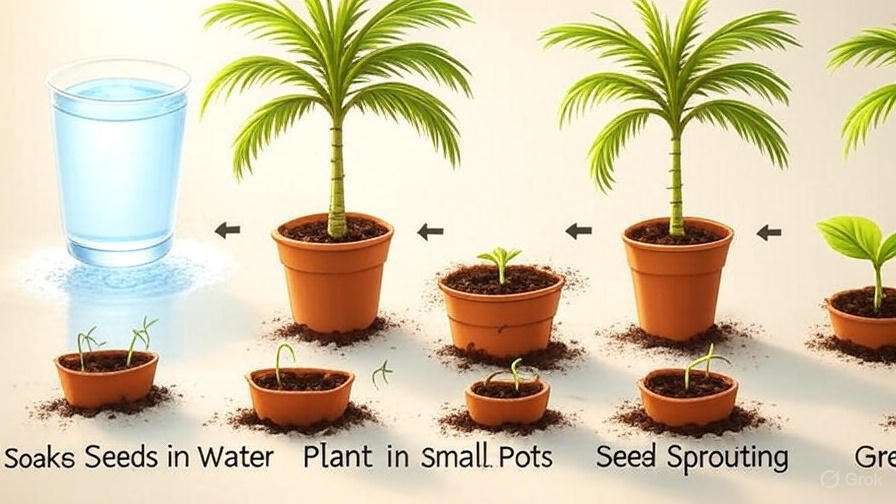
Conclusion 
Small palm trees can be a stunning and low-maintenance addition to your home or garden when cared for properly. By providing the right balance of water, light, humidity, and occasional feeding, you can keep your palm healthy and vibrant for years to come. Remember to regularly check for pests and signs of stress, such as yellowing or wilting leaves, so you can address any issues early on.
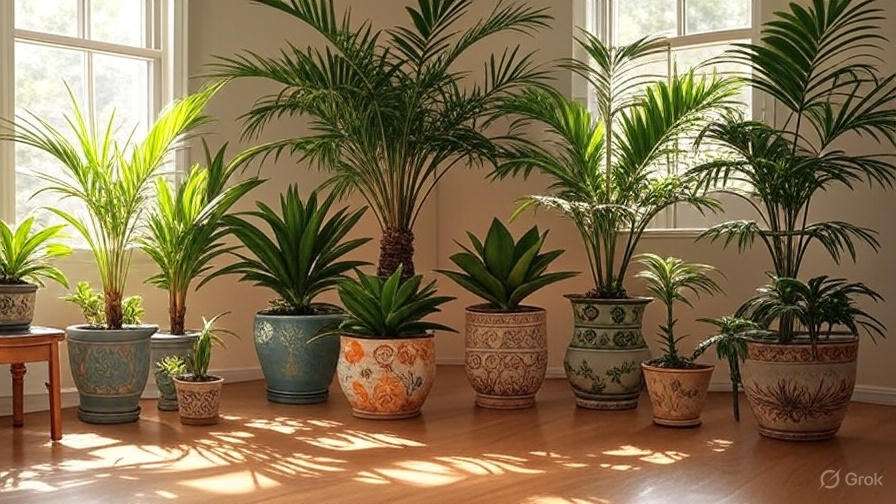
With the tips shared in this guide, you’ll be well-equipped to troubleshoot common problems and help your palm thrive. Whether you’re a beginner or an experienced plant parent, small palms are an easy, rewarding plant to grow.
Happy gardening!
Frequently Asked Questions(FAQ)
What are the best small palm trees for indoors?
The best small palm trees for indoor spaces include the Parlor Palm, Areca Palm, and Bamboo Palm. These palms thrive in indirect light and are easy to care for, making them perfect for low-light areas like apartments or offices.
How often should I water my small palm tree?
Small palm trees typically need to be watered when the top inch of soil feels dry. Ensure the pot has good drainage to avoid waterlogging. Water thoroughly but don’t let the plant sit in standing water to prevent root rot.
Can small palm trees grow in low light?
Yes, many small palm varieties like the Parlor Palm and Bamboo Palm can grow in low light conditions. However, they still need bright, indirect light to thrive. Avoid direct sunlight, as it can scorch their leaves.
Do small palm trees need a lot of sunlight?
Most small palm trees prefer bright, indirect sunlight. While some varieties can tolerate lower light levels, they generally grow best when exposed to light for several hours a day, but not directly under the sun’s rays.
How can I make my small palm tree grow faster?
To encourage faster growth, ensure your small palm tree gets the right amount of light, water, and nutrients. Use a balanced fertilizer every 4-6 weeks during the growing season and repot the plant when it becomes root-bound.
Why are the leaves of my small palm tree turning yellow?
Yellowing leaves on small palm trees can be caused by overwatering, underwatering, or a nutrient deficiency. Check the soil moisture and make sure your palm is receiving enough light. Also, consider using a palm-specific fertilizer to address nutrient needs.
Can I keep a small palm tree outside in the garden?
Yes, many small palm trees like the Dwarf Palmetto or Pygmy Date Palm are well-suited for outdoor gardens, especially in warmer climates. Ensure the soil is well-drained, and choose a spot that receives indirect light for the best results.
How do I care for a small palm tree during the winter?
During the winter months, reduce watering as small palm trees enter a slower growth phase. Keep them in a location with moderate light and avoid placing them near heat sources like radiators, which can dry out the air. Some palms may benefit from added humidity during this time.

